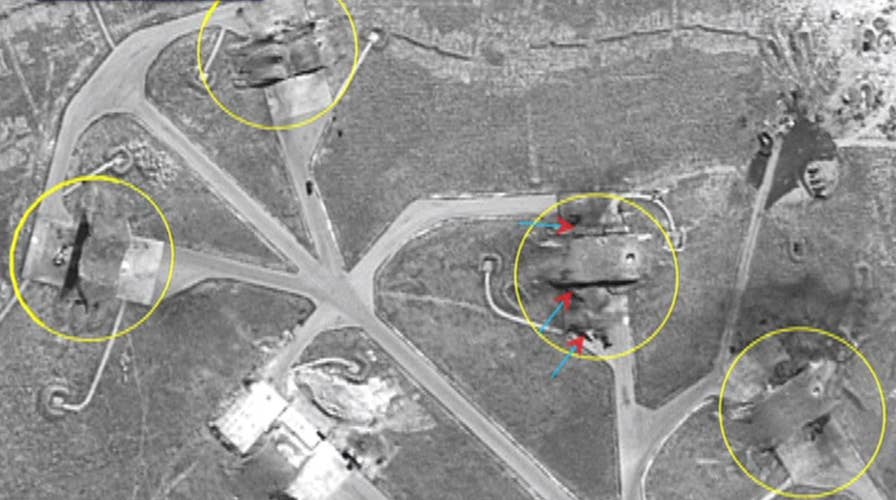Destruction from US strike on Syria seen on satellite images
Jennifer Griffin reports from the Pentagon
President Donald Trump’s airstrike attack of a Syrian military air base near Homs on Thursday night added another layer to an already complicated civil war, and marked the U.S.'s first direct attack on the Syrian government.
Developments over the last six years are key to understanding how anti-government sentiment escalated to civil war in Syria.
SYRIA MISSILE ATTACK: SATELLITE PHOTOS SHOW MAJOR DAMAGE TO AIRFIELDS
Protests
The Assad family has been in control of Syria since 1971, when Hafez al-Assad became president. In February 1982, he ordered a nearly month-long military besiegement of Hama to crack down on the Muslim Brotherhood’s anti-government uprising. The attack left about 30,000 civilians dead, according to the Syrian Human Rights Committee.
When Hafez al-Assad died in 2000, his son and current president, Bashar al-Assad, took control of the country. In 2011, inspired by Arab Spring protests against then-Egyptian President Hosni Mubarak, Syrians took to the streets in anti-government protests.
The turning point came in March 2011, when security forces arrested and tortured a group of boys for painting anti-government graffiti on their school, according to Al Jazeera. The response from the Syrian government in follow-up protests were violent, including security forces firing upon demonstrators in Darra later that month and raiding a sit-in in Homs in April 2011. Protesters began to arm themselves as a result.
Power struggle
As the anti-Assad rebellion grew, local militias and Syrian Armed Forces defectors formed the Free Syrian Army – an armed group aimed at toppling the Assad regime.
MCCAIN CALLS FOR RENEWED SUPPORT FOR FREE SYRIAN ARMY, ESTABLISHMENT OF NO-FLY ZONES
Beyond policy, anti-government sentiment began taking sectarian tones as the majority of opposition fighters were Sunni Muslims, according to the BBC. Sunni Islam is the most popular religious domination, but Assad is part of the Shia Alawite sect.
Instability in the area with gunfights and indiscriminate attacks spreading across the country also were compounded with the growing Islamic State movement. Attacks conducted by the Islamic State gained global attention, leading to the U.S. conducting airstrikes against the jihadist group in September 2014.
Danger and violence from these factions have forced at least 5 million Syrians to flee their homeland since the conflict began, according to the U.N. High Commissioner for Refugees, sparking an ongoing global humanitarian crisis as refugees seek safety in other countries.
Chemical weapon attacks
Suspected state use of chemical weapons is a recurring issue. In March 2013, a sarin nerve gas attack killed 26, including government soldiers in Khan al-Assal, Syria. Then, in August 2013, hundreds were killed after ground-to-ground missiles filled with sarin nerve gas struck the rebel-held civilian suburbs of Damascus.
Then-U.S. President Barack Obama said in 2012 that the use of chemical weapons would change his stance on intervening in Syria’s civil war.
REVEALED: FIRST PHOTOS OF ASSAD AIDE HEADING SYRIA'S CHEMICAL WEAPONS UNIT
Facing possible intervention and pressure from the U.N. Security Council, in October 2013, Bashar al-Assad agreed to add Syria to the Chemical Weapons Convention. The agreement “aims to eliminate an entire category of weapons of mass destruction by prohibiting the development, production, acquisition, stockpiling, retention, transfer, or use of chemical weapons” by member states. In turn, member states are expected to enforce the chemical weapons prohibition within their jurisdiction.
The Organization for the Prohibition of Chemical Weapons (OPCW), the implementing body of the Chemical Weapons Convention, reported in June 2014 that all of Syria’s chemical weapons were removed. But Syrian opposition officials contested the finding, stating that not all the weapons were accounted for.
In August 2015, at the behest of the United Nations, the OPCW was deployed to investigate reports of state chlorine gas attacks against civilians in rebel-held areas. The panel eventually found that the Syrian government used helicopters to launch chlorine gas in civilian areas of the northern Idlib province.
Foreign players
Russia has backed Assad by offering arms and political support. To complicate matters, it is suspected that Russia’s involvement in anti-Islamic State airstrikes actually have targeted opposition-held areas, including hospitals and schools.
Amnesty International reported evidence of "at least six deliberate attacks on hospitals, medical centres, and clinics in the northern part of the Aleppo Countryside governorate in the past 12 weeks."
RUSSIAN WARSHIP STEAMS TOWARD US DESTROYERS THAT LAUNCHED SYRIA STRIKES
Syria also finds support in neighboring Iran.
Other countries in the region, including Saudi Arabia and Turkey, have backed Syrian rebels. The U.S. also helped to arm rebels to dually fight the Assad regime and Islamic State militants.
U.S. airstrike on Syrian airbase
The order of missile strikes on an airbase near Homs was in response to Syrian President Bashar al-Assad’s suspected chemical weapons attack on civilians Tuesday that “choked out the lives of helpless men, women, and children,” Trump said in a televised address. The assault marks Trump’s most significant military action since taking office in January.

